Are you building a house in Philippines? See sample house plans and contact me to design new house for you!
The Philippines is a beautiful country until we talk about living conditions and government. One of the poorest countries in the world, ruled by one of the most corrupted governments in the world. Corruption and geography isolation keep foreign investment away, good paying jobs are hard to be found, so about 10% of country population is working overseas, and build beautiful houses when they return home.
Philippines have one of the highest income inequality of the world. They built an impressive business district in Makati City (above photo) and Fort Bonifacio Global City in Taguig, while half of population lives in poverty (less than $1.25 per day).
Population and housing statistics
Philippines population has grown from 27 million people at 1960 census to 60 million people at 1990 census.
2000: household population 76,332,470, number of households 15,275,046, average household size 5.0
2010: household population 92,097,715, number of households 20,171,899, average household size 4.6
2015: household population 100,573,715, number of households 22,975,630, average household size 4.4
Source: psa.gov.ph
Additionally, at least 12 millions filipinos are working overseas, according Wikipedia.
If in the past USA was preferred work destination, since 2000s most overseas workers went to Middle East, but you can find filipinos on every continent. I can tell this from my personal experience of architectural designer. I have been contacted by people from all over the world telling me that build houses in Philippines, and this even before writing this article. Actually half of my customers in Philippines contacted me from an IP located in another country.
I believe that the booming economy, lack of public housing programmes and too few large-scale private housing developments, made people to build houses themselves, browsing the internet for floor plans, find my international website and contact me for custom house design.
While many people from Philippines choose to emigrate or work overseas, Philippines is also a destination for foreign expats looking for a cheaper place to live. Many Americans are living in Philippines, I personally don’t understand (maybe someone can explain me?) why people from such developed country would move to a third world country where living conditions, education and health system are much worse and crime ratio is high. YouTube is full of videos about moving or against moving to Philippines. If you want to have same living conditions you had in United States, a big house, a car, have kids in private school, etc, the cost of living is not much cheaper than in United States.
(personally I considered Philippines a better country than it actually is, until local people who contacted me for house projects, also informed me about bad living conditions)
General review of housing
Philippines have beautiful architecture, there are a lot of beautiful, over-decorated houses, but this architecture style mask the fact that Philippines houses are among smallest in the world.
Filipinos are also one of the shortest people in the world, but I still see their homes ridiculously small. Bedroom around 6-7 sqm, making 3 bedroom houses to be about 50 sqm, size comparable with Hong Kong apartments despite of much larger country. Worse than this, most apartments are studios or 1 bedroom, compared with Hong Kong which is dominated by 2-3 bedrooms. In subdivisions built by major real estate developers, houses are usually 2-3 bedrooms.
If this was not worse enough, there are many people living in informal settlers (aka slums, squatters), of the rest who have legal land titles, many built houses that still looks like slums. In downtown Manila every unused piece of land get occupied by informal settlers, river beds are also heavily built, people living above highly polluted water and in danger of flooding. Even the 8-meter wide land between railways and nearby streets is the home for numerous poor families (cannot imagine how you can sleep as the trains horn continuously).
There are too many informal settlers for the government to take care about them. Government is trying to clear the slums from Philippines National Railway land and from danger areas such as river beds, and move them into socialized housing built at city outskirts, but people do not want to live there and move back to slums, which are conveniently located near workplace and amenities.
This is Forbes Park subdivision in Makati (average home price 5 million USD)…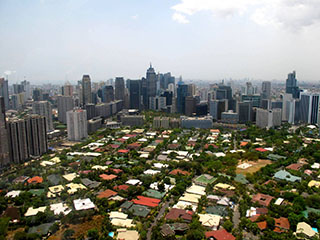
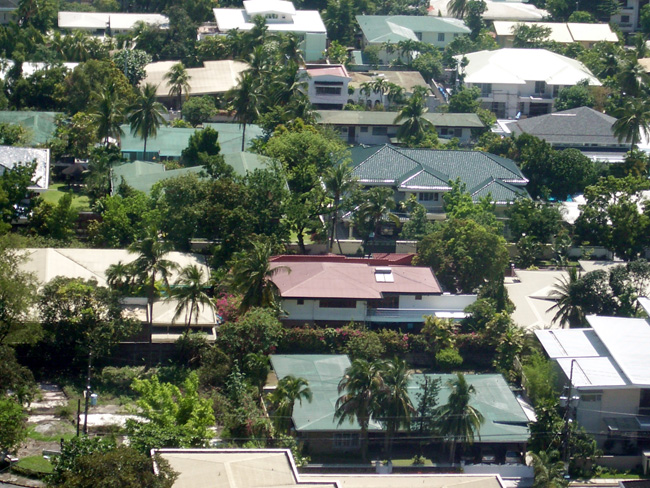
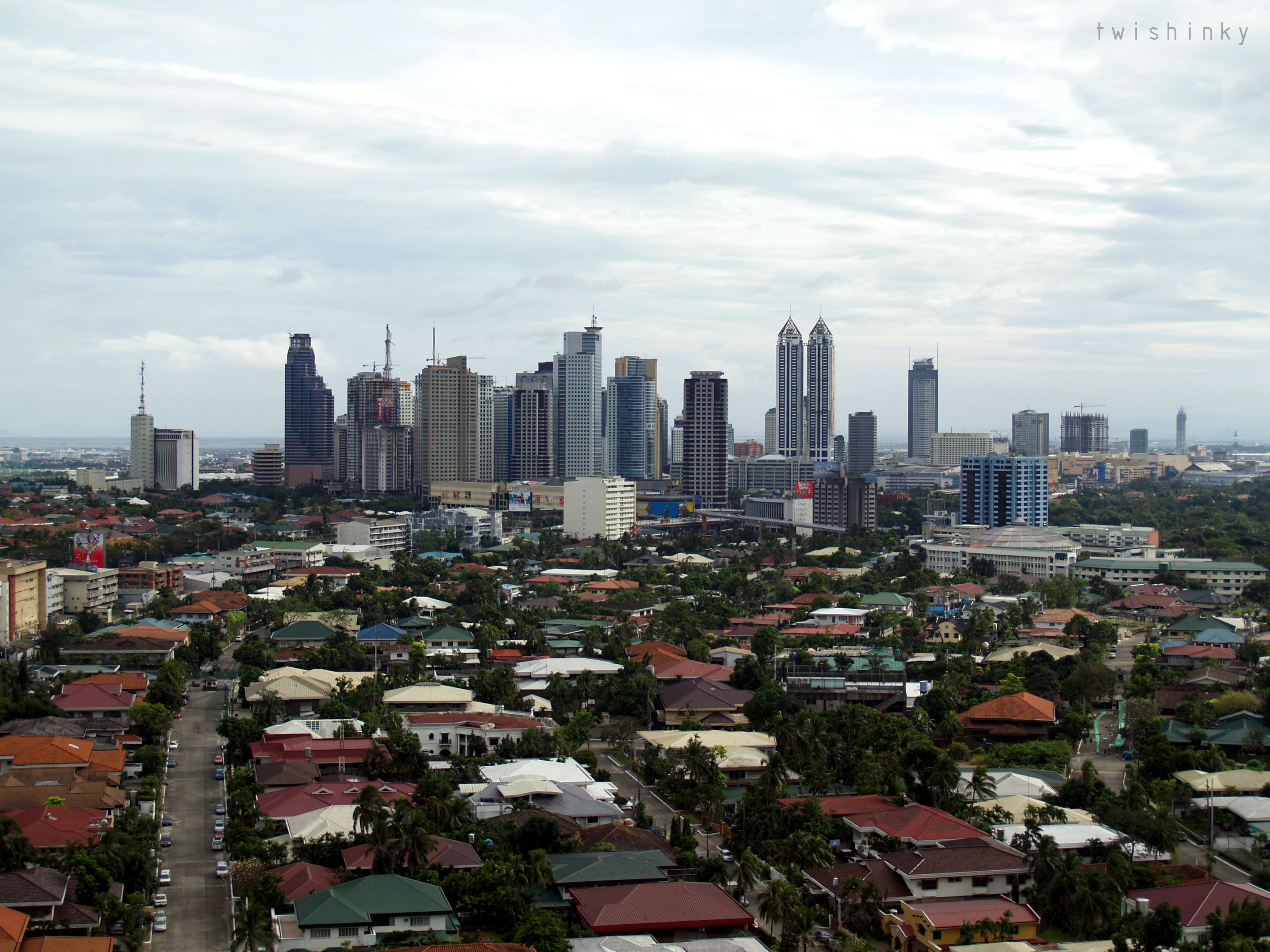
…and the typical Philippines houses from Metro Manila near Makati!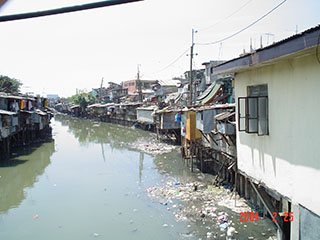
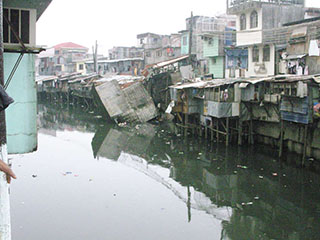
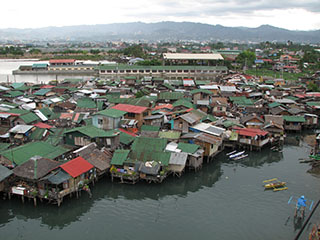
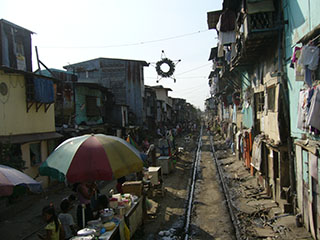
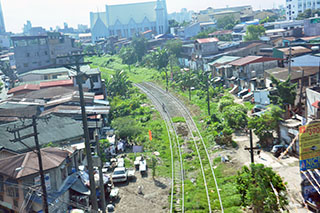
“Happyland“, weird name for the biggest slum in Manila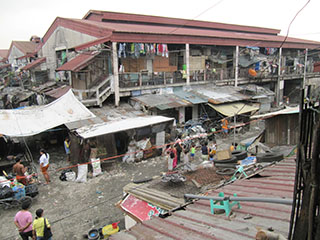

New housing estates (called subdivisions) are being built by private developers at city outskirts, less-dense developments, large open spaces, gated communities with guards, clubhouse and swimming pool.
The fastest developing cities are Dasmariñas, Bacoor and Inus (30 km south from downtown Manila, within Cavite province), here are the most subdivisions and most beautiful architecture, less slums and more wealthy people.
Modern housing developments in Cavite, Angeles and Mactan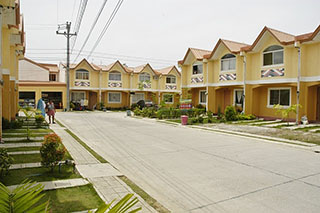
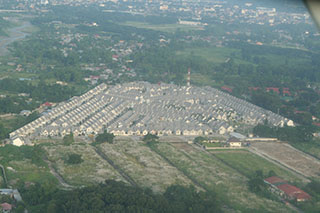
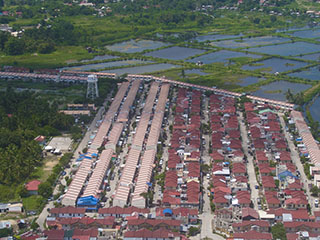
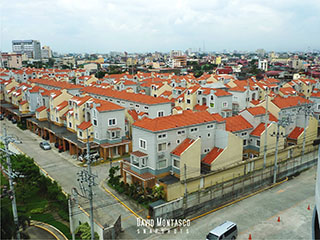
Beautiful houses from Eastwood Greenview subdivision – Slums of the poor built on Philippines National Railway
Government does NOT provide statistics regarding house sizes, my personal estimation is that average size are around 30-50 sqm in legally-built developments, but a significant amount of population lives in slums which their house size cannot be defined, some slums having just a small enclosed area for sleeping, people spend whole day outdoor. Is common to see families of 10 people sleeping in a 5 sqm space.
While population was rising, cities did not expanded much horizontally but rather became denser and denser, in Metro Manila lots are over-subdivided by successive family generations and nowadays there are entire families squishing on lots small as 20 sqm.
What I do not understand yet, is why in smaller cities and countryside, where the land is cheap, people own large plots but still build extremely small houses. Living in tight spaces is part of Philippines culture?
Philippines housing types
Subdivisions (aka Housing Complexes in other countries) became more common after year 2000. Rowhouses on plots small as 3.5 meters wide and 10 meters deep, with 24 meters between street axes, reaching densities of about 200 housing units per hectare, probably the densest housing development in the world (example: Ximena Mabalacat – floor plan).
Single detached = house surrounded by courtyard on all 4 sides, houses built at minimum 3 meters apart (1.5m setback for both houses).
Single attached = a definition that do not exists in any other country, with 1 or 2 firewalls (walls built at 0-lot boundary), built with same orientation so everyone is having windows facing to neighbor’s blank wall at 1.5m apart, giving the advantage of detached houses without shared walls. Sometimes the carport roof is attaching houses. They are VERY UGLY because on one side the roof is overhanging 700mm and on other side there is a blank wall that extend above roof.
Duplex = semi-detached, 2 houses symmetrical.
Rowhouse = synonym with british Terraced house or american Townhouse.
Bungalow = single-storey house, similar with American meaning. Unlike the rest of Asia where bungalow means a detached house regardless of number of floors.
Nipa hut = Philippines traditional houses found in rural areas, made by bamboo and other wood, they are so light that if you want to move somewhere else you can ask few villagers to carry your house on their shoulders “human snail” as seen in the below video, a practice called bayanihan. I do not understand the reason of moving since this type of move is limited by people’s walking distance.
Most common housing typologies in these subdivisions:
40 sqm 3-bedroom back-to-back terraces on 5×8 m land (example: Cedar Residences – floor plan – I wonder how you can reach house door after parking, carport is 2.5 m wide and an average car 1.8 m wide will block the door).
50 sqm 2-bedroom terraces on 4×10 m land, (example Portville Mactan).
The subdivisions offer also bigger houses with 3 and 4 bedrooms but very few of them are over 100 sqm.
As 2014, prices of the 2-bedroom 40-50 sqm terraced bare houses vary from about 1 million PHP (22,000 USD) in Cavite to 3 million PHP in Metro Manila. 3-4 bedroom 100 sqm detached finished houses are 3 million to 10 million PHP.
Housing design regulations
In urban areas (non-subdivisions), according my study from satellite photos, most lots are within 4-10m wide and 10-16m long. Most plots vary from 40 sqm (minimum by law) to 120 sqm, very few lots are more than 120 sqm of land in urban areas. 80-120 sqm looks being average lot size. However, some people asked my help to design house plans for lots small as 20 sqm.
Philippines building code regulate habitable rooms at minimum 6 sqm and 2 meters wide, most houses are built at these minimum values, but corruption in real estate allow developers to build even smaller rooms, examples: Pioneer Woodlands bedrooms are less than 2m wide, Angeles, floorplan 25.5 sqm 2-bedroom home, bedrooms should be 1.9 x 2.4m internally.
For comparison, a nearby country Malaysia building code says 6.5 sqm bedroom and 9.3 sqm master bedroom, but these minimal sizes are rarely seen and only in public housing. I never seen any developer in Malaysia building anywhere closer to minimum requirements, they build usually 10-15 sqm common bedrooms and 15-25 sqm master bedroom.
House setback are 1.5m in front and sides, and 2m at rear. I never found a clear regulation about carport roofs and balconies within setbacks.
Ceiling height should be minimum 2.4 m, and 2.7 m for first floor, but in most houses, all floors are 2.4 m.
Bad house design: as seen in floor plans provided by developers, living room is so small that you cannot place a sofa, TV and dining table in same time, or dining chairs once pushed out, block the way between kitchen and bedrooms.
Kitchen stuff (sink, stove, fridge, cabinets) are together only 2 meters long. Some low-cost houses do not even have kitchen inside, sink being placed outdoor (so you are bitten by mosquito while washing dishes?).
Carports are often designed 2.5 meter wide, minimum by law, the floor plans illustrate cars but insufficient space to open car door (so how you can get out of car?), or the car is blocking the way to house main door. No wonder why we see many people parking on roadside. The idiot architects don’t know that 2.5 meter wide is OK only for open carparks, garages or any parking space between walls should be 3 meters minimum width, today cars average 1.8 m width and you need 90 cm space on driver side and 30 cm on other side.
I need feedback from local people. I understand that a large part of population is poor so low-cost housing is needed, but are these houses big enough for people needs? Or people will extend it over courtyard and destroy the urban landscape, like in Mexico?
Good website: www.pinoyrealty.com, few dozens house models, all with floor plans shown on site.
More stuff
Anyone who know or find resources about building code regulations across history please contact me!
According hlurb.gov.ph/wp-content/uploads/services/developer/rule1.pdf, the minimum lot areas and is rowhose 50 / 4m, duplex 80/attached sqm / 8 m, detached 100 sqm / 10/12 m (medium housing).
According hlurb.gov.ph/wp-content/uploads/services/developer/rule1n2.pdf, the minimum lot areas and frontages are: rowhouse 32 sqm / 4 m, duplex/attached 48 sqm / 6 m, detached 64 sqm / 8 m (economic / socialized housing).
According hlurb.gov.ph/wp-content/uploads/laws-issuances/board-resolutions/BR_824.pdf, the minimum lot areas and frontages are: rowhouse 36/28 sqm / 4/3.5m, duplex/attached 54/48 sqm / 6 m, detached 72/64 sqm / 8 m (economic / socialized housing).
Which is the truth??
http://grem.ph/realty-resources05.php specify different laws, setbacks 3 m at front, 2 m at back, 1 m at sides.
More strange examples found during my study
Possible smaller house: Wallnut Grove, 22 sqm 1-bedroom house, 4m wide and 5.5m deep (smallest house ever?). Neither living room or bedroom looks wider than 2 meters.
Gran Seville, 36 sqm single-floor 2-bedroom house measuring 6x6m
Greeensbolough Dasmarinas, 40 sqm 3-bedroom house
M Place, block with apartments from 16 sqm studio to 40 sqm 2-bedroom
Cambridge Village, Condo with 2-bedroom apartments small as 30 sqm.
The Stratford Residences, 68-storey condo dominated by studio and 1-bedroom apartments. 3-bedroom apartments are only few on top 8 floors.
Note that all these horrible tiny houses are examples of LEGAL buildings, designed by architects and build with permit from government. Imagine that the slums are even worse!
Can’t find an empty plot of land? No problem, build OVER ROAD!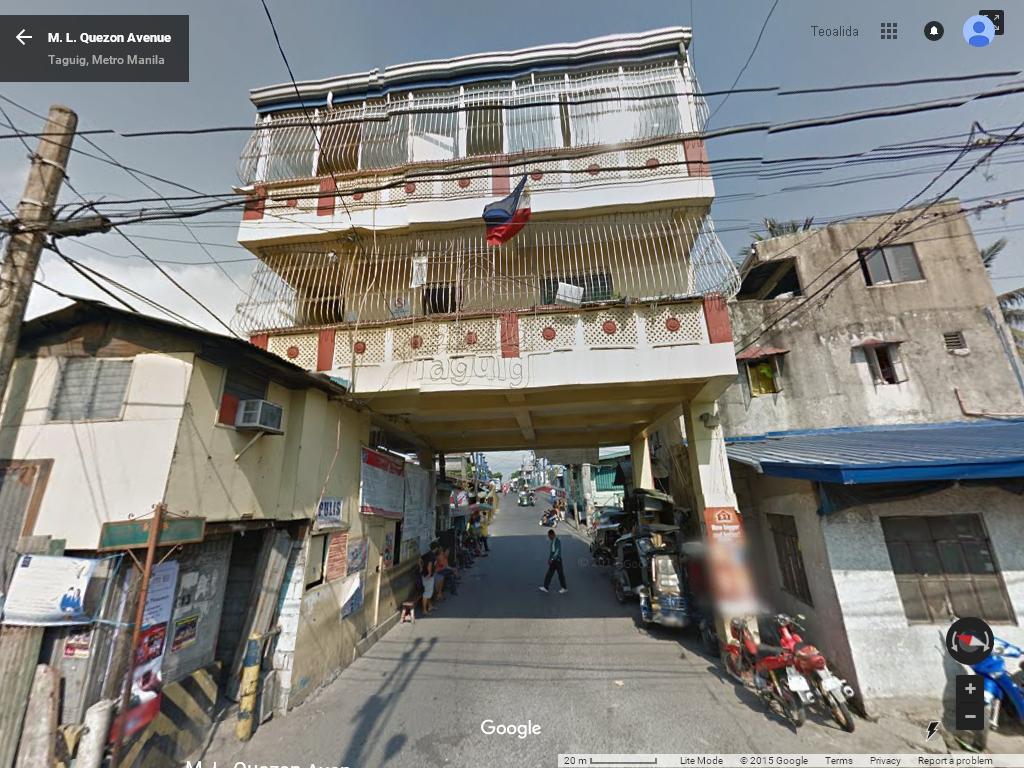
Transportation
Manila Light Rail / Metro Rail was the first metro system in South Asia, opened 1984 but development was slow and presently it have only 3 lines totaling 51 km.
There are also modern buses, but most common means of transportation is the Jeepney, originally US Military vehicles which (few hundreds vehicles) were sold to locals when troops retired at end of World War II, locals converted them in buses by extending their wheelbases and installing roofs, and over-decorated, calling them Jeepney. Nowadays most Jeepneys are made 100% locally, resembling the shape of American Jeep but made 6-7 meters long, others are based on second-hand Japanese SUV, vans and trucks, still called Jeepneys despite being unrelated with American Jeep). About 50.000 Jeepneys are driving around Manila (according BBC).
These vehicles are over-decorated with various texts, religious messages and other bullshit, but not with their route (so how people know to pick the right one!?). They follow chaotic routes and stop anywhere even in middle of road, putting passengers in danger. In rural areas is common to see Jeepneys overcrowded with people sitting on their roofs, despite that it is an illegal practice (example video).
Another form of transportation unique in Philippines are Owner Type Jeep, hand-made vehicles resembling the US Jeep but in miniature, less than 3 meters long, most lacking seatbelts, windshield wipers, or other features standard for western cars since 1960s. Does anyone know what engine they have?
Philippines also have tricycles, common also in other South Asian countries, made from bicycles and motorcycles with a bench attached supported by a 3rd wheel, and roof. Some are even used as taxis. When you see a car, it looks giant compared to traditional vehicles!

More charts with price index in Singapore, Thailand, Indonesia, Philippines on systemisbroken.blogspot.com
Page published for first time in 2012 and updated over next years with more information found by me or provided by visitors. Text written by me (Teoalida) and images taken from Wikipedia, Panoramio and other websites. Do you have useful information that worth adding? Did you found an error or have a contradictory opinion? Leave a comment!


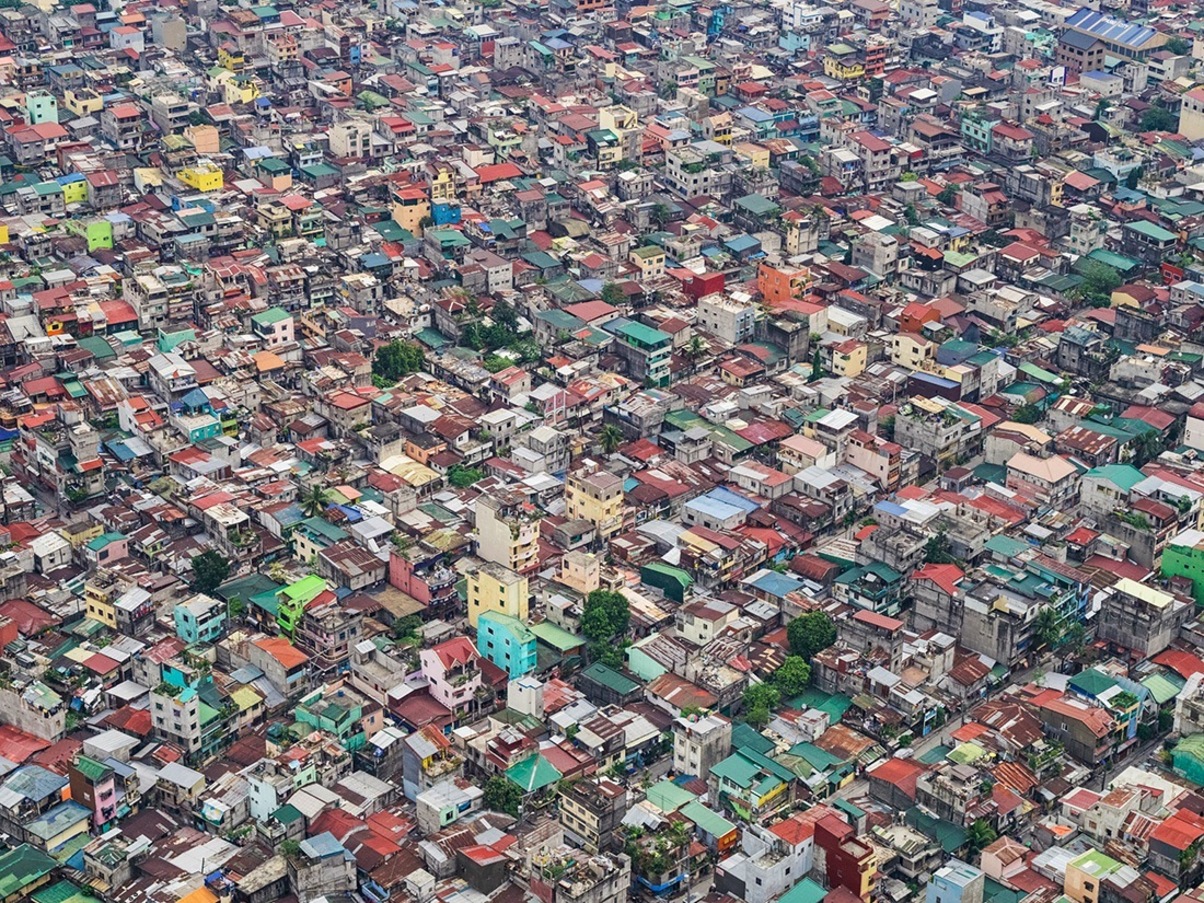




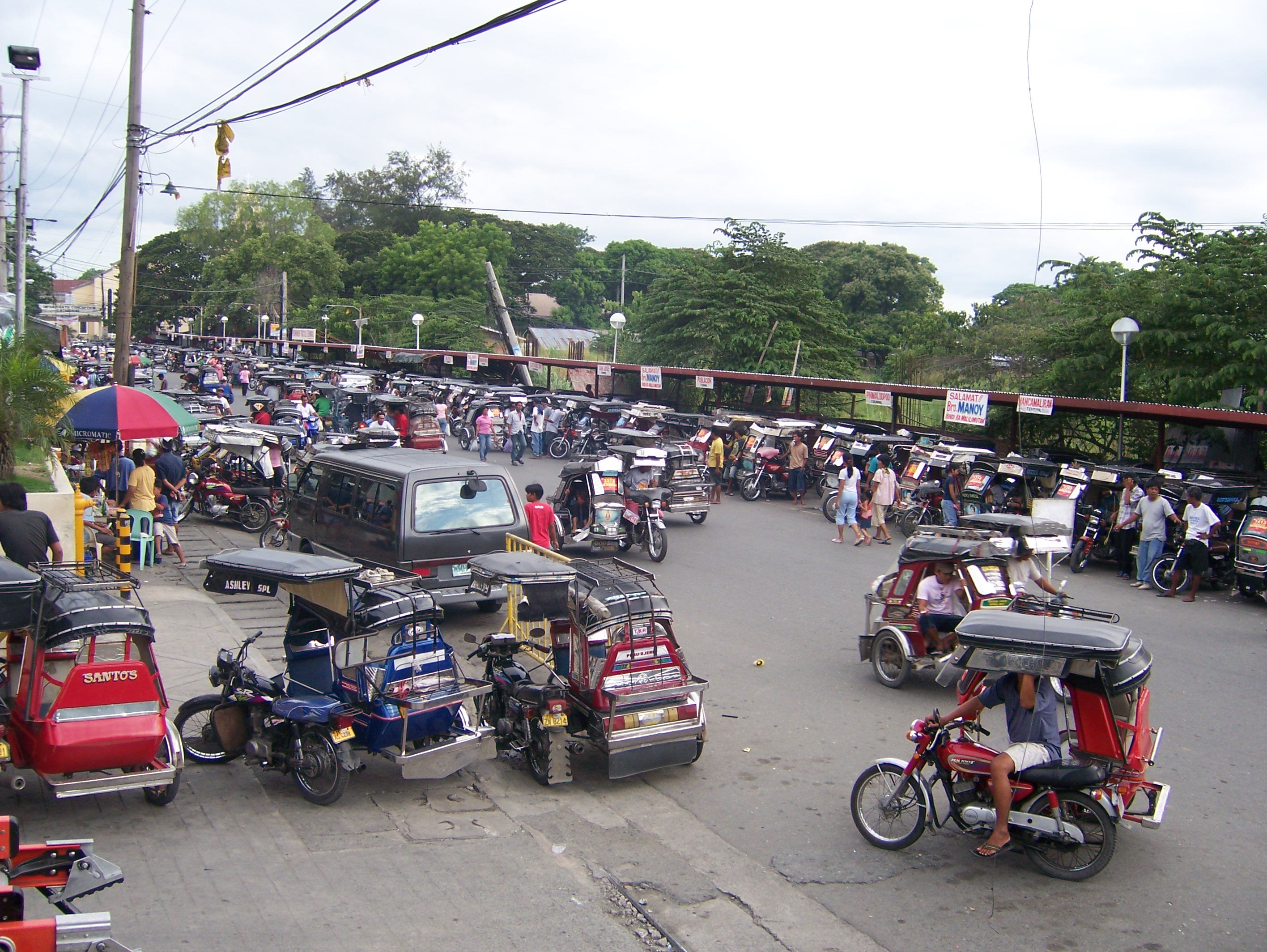
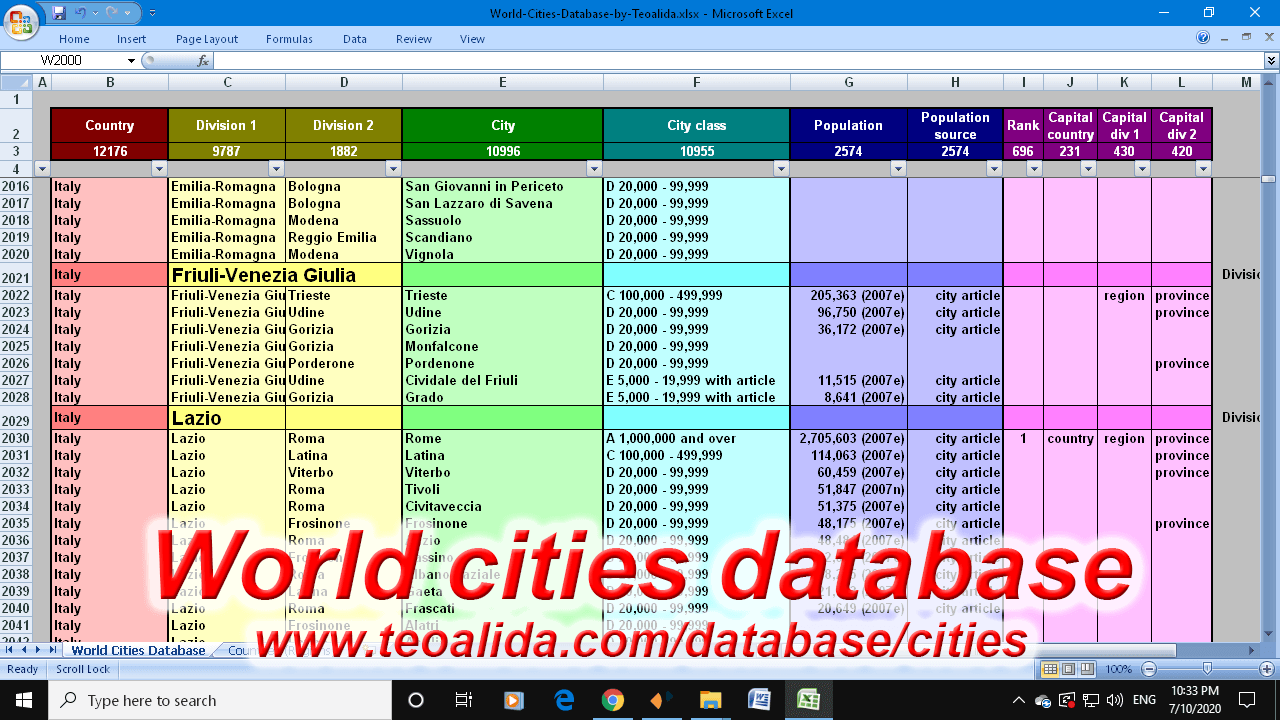

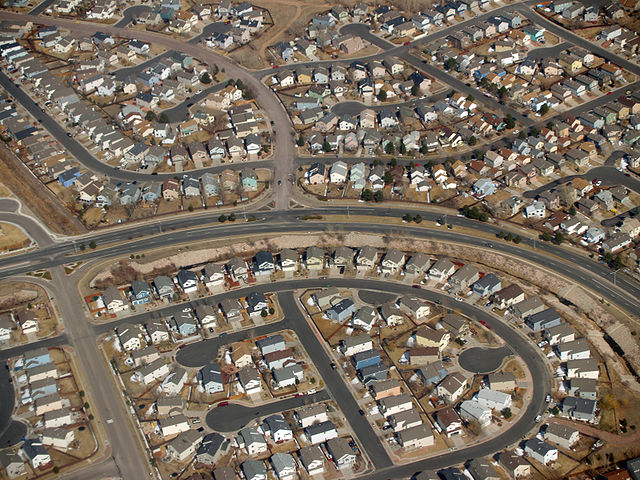
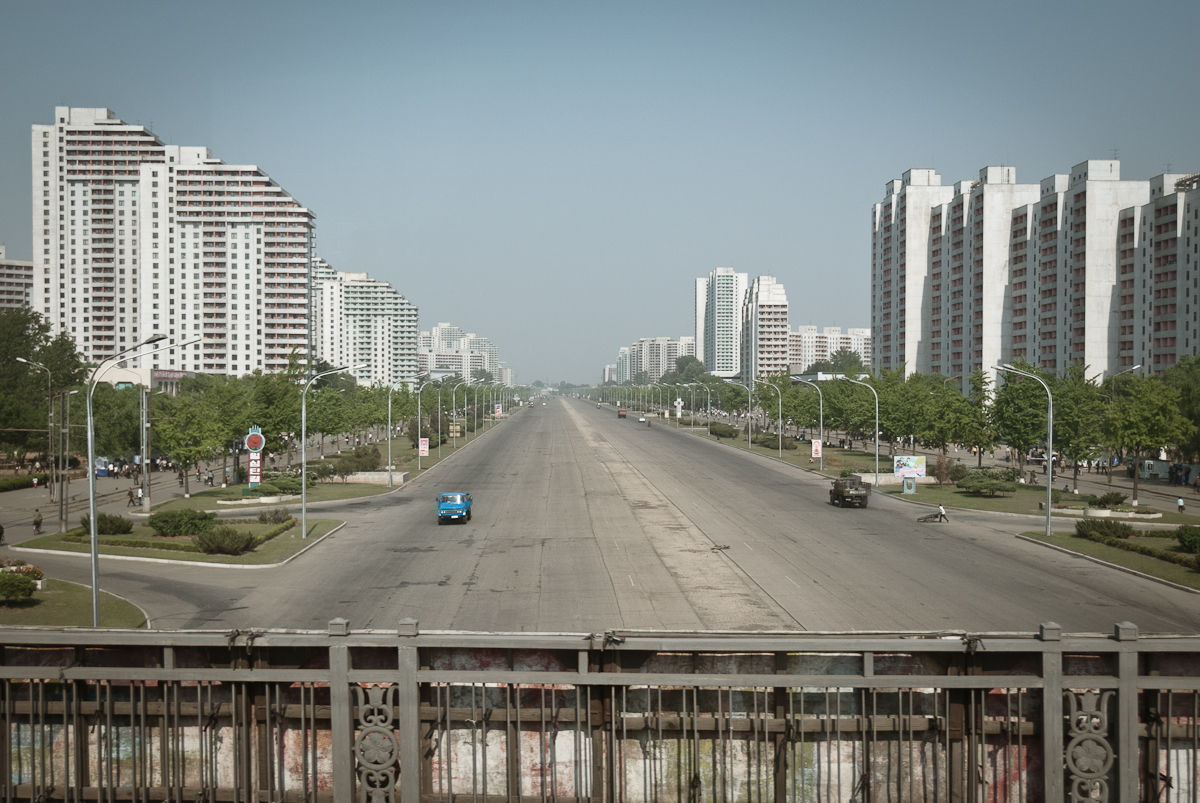
people in philippines love cheap houses. lots of them believes that the bigger the house is, the larger cost of money. well, that’s what filipinos believe but not all of us. and if you’re asking why 1 bedroom each house, it’s because the whole family sleep together in just one bed. It was just a simple answer but that’s the truth. the husband and wife sleeps together with their children. hope my answer will help.
I have read this post and if I could I wish to suggest you few interesting things or tips.
And… what are you waiting for? Feel free to tell your suggestions!
it is because of the price of the lot. The bigger the lot, the more expensive it will be. So a bigger house would mean it will be more costly. Also,the reason apartments are smaller in the Philippines than in Hong Kong is because of the population density. Hong Kong has smaller population that is why there are more space available than in the Philippines where cities are mostly over populated.
How you can say that Hong Kong have more space available?
Hong Kong population density is 6500 people / sq km compared with Philippines 300 people / sq km.
I think that there is a problem with over-subdivision of lots and the laws regarding minimal plot sizes (which are meant to be broken anyway) should be changed… let’s say minimum 60 sqm for terraced, 80 sqm for semi-detached, 120 sqm for bungalow.
The density of the Philippines is much less, but Metro Manila is very densely populated (approx. 19,000/sq km).
So why there are small houses built in mass OUTSIDE Manila? Bacoor, Imus, Dasmarinas… all are full of houses averaging 50 sqm built on 40-80 sqm lands.
Hello, I would like to tell you that our some of our Corrupt politics are being arrested for now.
hi. we have a 60 sqm lot 4 meters frontage and 15 meters length. we’re planning to build a 3 storey building which will be occupied by 3 families (one family per floor). our biggest area of concern is the stairs that will allow access to all the floors including the roof deck. we’re looking at 2 bedrooms on the ground floor & up to 3 bedrooms on the 2nd & 3rd floors.
hope you can help us out. thanks in advance.
I am sorry for you and all other people in Philippines who live in such poverty and crowded on small lots…
This is maximum you can get, 2 bedrooms and windowless living room: https://www.teoalida.com/design/sketches/Proposal-for-jomari04142014.png
Even if according living room size, you can cut 6 sqm and make a 3rd bedroom, this is impossible in 4m wide because will require an additional ventilation airwell and will block access to other rooms.
Thank you so much for your prompt reply. I’ll show the design to my brother.
Hi.. we have a lot 60 sqm. we are planning to build 2-3 storey to make it as a boarding house or dormitory for students to rent.
Ground floor:
1 bedroom for the owner/landlord
toilet with separate bath
kitchen
small living room/dining room
2nd floor
rooms for boarder/students
Hope you can help me out. Thanks
Without providing me length and width of your 60 sqm lot, how do you think that I can help you with a design?
And the students room how big should be? Bathroom and kitchen included, or communal?
I would like to ask for help if you can sketch a design for me a floor plan with 80sqm meters 10 in width and 8 in length with 2 bedroom and 1 Master bedroom with toilet and 1 common toilet, 1living room and 1 kitchen
Do you need just a sketch floor plan? No elevations, sections, 3D design?
Here is one made past year: https://www.teoalida.com/design/Bungalow-House-38-56sqm.png as coincidence the 2-bedroom version is exactly 8 x 10 meters, with one firewall. If you want a different sketch with more firewalls or master bedroom with en-suite toilet, or a complete project including 3D design, tell me!
What you are doing is illegal. Only licensed individuals are allowed to practice architecture in the Philippines. You don’t even have a proper knowledge of the local codes (BP 220, PD 957, PD 1096, etc.) You poison the profession. Please stop your dealings.
Excerpt from RA 9266:
SECTION 25. Registration of Architects Required. – No person shall practice architecture in this country, or engage in preparing architectural plans, specification or preliminary data for the erection or alteration of any building located within the boundaries of this country or use the title “Architect,” or display or use any title, sign, card, advertisement, or other device to indicate such person practices or offers to practice architecture, or is an architect, unless such person shall have received from the Board a Certificate of Registration and be issued a Professional Identification Card in the manner hereinafter provided and shall thereafter comply with the provisions of this Act.
Is NOT illegal to make a website, design floor plans and 3D models of buildings, and say that I offer CAD design services. Drawing in AutoCAD is a hobby dating back from childhood and cannot be stopped just because someone thinks that is illegal.
May have been illegal to pretend to be an architect, sign drawings and submit for building permit without license, and I DON’T do this. I clearly said in About Me page that I am AutoCAD designer, not architect or that I offer architecture service.
There are many people like mine providing similar architectural designs without being actual architects. Example: http://www.3drenderingindia.com/ or http://jahnbar.hubpages.com/ which is a Filipino engineer (not architect) but his website promote house designs like me.
But to be honest… I am in “grey area” when I serve people asking me to make architecture drawings AND they are building houses on them. This happen because in 2012, when I was a simple AutoCAD designer loving to design buildings as hobby with nearly zero knowledge of architecture, an architect offered me to collaborate and advertise my services, encouraging me to go into this profession so I changed website banners to attract customers and started learning how to make architectural drawings (read full story https://www.teoalida.com/offtopic/architect-put-me-on-wrong-track/). Over years I got both positive and negative comments regarding legality of what I am doing, mostly positive and encouragement, coming in conclusion that the 2012 architect was an idiot, and that is legal to offer my service only if I collaborate with a licensed architect if someone needs a complete project. Would you like a collaboration? I learned a lot about architecture last 3 years but I still have a lot to learn.
Do note that 9 of 10 people contact me for free consultation and a simple sketch, I warned few of them that I am NOT architect, but they insisted to work with me or asked me why I am trying to scare them away, so I had to stop warning people. Most of customers are in third world countries where building without permit is common. Sometimes people pay me for a sketch then give it to a local architect to make complete project, so my signature is not needed and my earnings are very small. Architecture and CAD design produce now only 10% of my total income, down from 50% in 2012, due of growth of my other business, myself I no longer enjoy architecture so there is no problem if I STOP offering such services, but PEOPLE keep demanding my services!
What is your suggestion in this case?
PS: you left INVALID EMAIL!
I emailed you next day because I wanted to talk more with you about this subject. Hope you will visit my website again and REPLY!
don’t listen to these bad people trying to make you to quit your business!!! what you do there is very good and we need your architecture service to rebuild our country. i have a lot in cavite 70 sqm i need 3 bed 2 toilet and garage can you make a draft floor plan?
I can make a sketch for you if you would provide length and width of that 70 sqm land. Without knowing exact dimensions you can see my pre-made sample drawings such as https://www.teoalida.com/design/Townhouse-69sqm.png
And I am sorry for all people in Philippines who need house designs from me, but I have less and less time for architecture. It NEVER been profitable with majority of customers are from India, Philippines, Africa, etc, and when majority ask for a free sketch and not paying for complete service. I need to quit architecture because I need time for my other business which makes more money, NOT because some idiot is telling me that what I do is illegal.
I think you can still continue your work by changing the title From Architect to Strategist? Do you think it will be work? You doing good stuff to many of us.
Where do you see me using title Architect? I never used title of Architect. I always said that I am AutoCAD designer, offering 2D and 3D design services, etc
I think you should try using the term draftsman so there won’t be any confusion.
a draftsman is a person who makes detailed technical plans or drawings.
Good Day,
Hi! I need help, Thank you, I have a lot of 13.31mX7.89m and planning to build duplex 2 bungalow house for rent with approx. 50sqm both. Can you sketch me 2 bedroom and 1 Master bedroom and 1 common toilet, 1living room and 1 kitchen. Thank you.
And also if the area is 80sqm 8×10m planning to build duplex 2 bungalow house for rent with approx. 40sqm both.
Thank you very much for the help.. will appreciate much.
From Batangas City Philippines,
You can’t build two 50 sqm on that 13×31×7.89 m = 105 sqm because you need to keep 1.5m street setback and also some space at rear for ventilation. Here is possible sketch, they are 36 sqm https://www.teoalida.com/design/Sketch-for-mohan.png
On 8x10m lot is impossible to build two 2-bedroom single-storey, why you don’t build 2 floors on both lots? such as https://www.teoalida.com/design/Tiny-House-54-56sqm.png
Good day!
I would like to ask you if it is possible to build 2 story duplex house in 113 sq.m with 1 room on the lower ground,1 living,dining and 2 common bathrooms(1 each floor) and 3 rooms on the second floor.By the way I like your sample house with 3+1 bedroom detached good for 80sq.m-100sq.m.Is it possible for our lot size?
Thank you! and God bless!
from,
Cavite City,
Philippines
Tell me length and width of that 113 sqm lot… but probably is possible, is enough space
Good day again,I dont know exactly the length and width of the lot,just got this measurement-8.12×13.66×14.16.and if ever we want you to make a plan for our duplex house,how much it will cost?thanks.
Looks that you mean DUPLEX = 2-storey house while other people mean house for 2 families (semi-detached).
Perhaps your lot is 8.12 m wide and 13.66-14.16 m long (longer on one side than in other).
You want detached house, no firewalls? Price: $50 x number of rooms = probably $200.